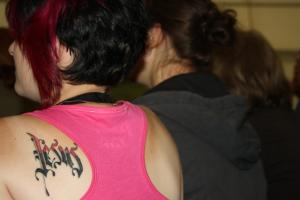
My Metaphors
Hair:
Yes, I am a 60-something-year-old woman, a modern grandmother, an educated professional. I am also “the woman at the well.” Perhaps that explains a couple of my non-conventional fashion choices–the metaphors I carry on my body.
Sporting my long, gray-streaked hair, I often fondly play out the following scenario in my mind:
“When one of the Pharisees invited Jesus to have dinner with him, he went to the Pharisee’s house and reclined at the table. A woman in that town who lived a sinful life learned that Jesus was eating at the Pharisee’s house, so she came there with an alabaster jar of perfume. As she stood behind him at his feet weeping, she began to wet his feet with her tears. Then she wiped them with her hair, kissed them and poured perfume on them” (Luke 7:36-38).
Jesus forgave that sinful woman! Jesus encouraged her! He even loved her! Just like Jesus forgives, encourages and loves me!
I also read that “Gray hair is a crown of splendor” (Proverbs 16:31) and “if a woman has long hair, it is her glory? For long hair is given to her as a covering” (1 Corinthians 11:15).
(Now before you go getting angry at me. NO, I DO NOT BELIEVE IT IS A SIN FOR A WOMAN TO CUT HER HAIR! A very dear Christian woman I knew was kicked out of her ultra-strict church because she cut her hair. The Jesus I know wouldn’t do that.)
What I am saying is that my waist-length, gray hair has become, for me, a metaphor. It is like faith, an outward expression of an inward commitment. Just as I would kneel before Jesus to wipe His feet with my hair, I would abase all my worldly glory before Him. All I have done for the good of others, all the positive things I have attempted, are only accomplished because He lives in me. I am only worthy to bow before Him because of His blood that He shed on my behalf–I am a sinner saved by grace.
Piercings:
Additionally, there is another metaphor that I wear on my body. I have five ear piercings–two on each lobe and one in the upper cartilage of my left ear. I chose to get five to represent the piercings of Christ on the cross: the nails in His hands, the nails in His feet, and the spear in His side. At any time I can reach up to touch them, and remember.
Other Metaphors
There are other metaphors that people wear on their bodies. I know very many Christian people, male and female, who have devotional tattoos. That topic can get pretty heated in traditional circles. In his article “Take Off Your Clothes, Flash Your Tats,” Gregory Smith explains: “When your skin is a canvas, people often take notice. Many people ask, ‘Can Christians get tattoos?’ I answer–Why not??? Some people treat their bodies as temples by decorating them with religious symbols because, if your artwork has spiritual meaning, it can be a great conversation piece. For some, that might mean saying ‘Yes, it’s a Christian tattoo—let me tell you what I believe.’” (https://www.patheos.com/blogs/breathingspace/2023/06/take-off-your-clothes-flash-your-tats/).
Common Metaphors
The Widow’s Mite:
Several years ago, my husband (a collector of old coins) gave me chain on which is mounted a small bronze coin–a widow’s mite. “The bronze coins of this story were not described in any detail, leaving it to scholars and numismatists to try to discern what specific coins were offered by the widow. They are widely believed to be what are known as lepton (which means ‘small’ or ‘thin’) coins minted by Alexander Jannaeus, King of Judea from 103 to 76 BCE and the great grand-nephew of King Judah Maccabee. Two lepta were worth a quadrans, the smallest Roman coin, and a lepton was the least valuable coin that circulated in Judea.” The necklace reminds me that when I give all I can, even when it’s not much, God understands. People ask me about it, and I’m glad to tell the story.
The Cross:
What about that cross you wear around your neck? I have several. What do you think the people of the First Century A.D. would think about that? What was “the cross” to them?
“…it appears likely that the mechanism of death in crucifixion was suffocation.
“The chain of events which ultimately led to suffocation are as follows: With the weight of the body being supported by the sedulum, the arms were pulled upward. This caused the intercostal and pectoral muscles to be stretched.
“Furthermore, movement of these muscles was opposed by the weight of the body. With the muscles of respiration thus stretched, the respiratory bellows became relatively fixed.
“As dyspnea [shortness of breath] developed and pain in the wrists and arms increased, the victim was forced to raise the body off the sedulum, thereby transferring the weight of the body to the feet. Respirations became easier, but with the weight of the body being exerted on the feet, pain in the feet and legs mounted.
“When the pain became unbearable, the victim again slumped down on the sedulum with the weight of the body pulling on the wrists and again stretching the intercostal muscles. Thus, the victim alternated between lifting his body off the sedulum in order to breathe and slumping down on the sedulum to relieve pain in the feet.
“Eventually, he became exhausted or lapsed into unconsciousness so that he could no longer lift his body off the sedulum. In this position, with the respiratory muscles essentially paralyzed, the victim suffocated and died. (DePasquale, N. P. and G. E. Burch. 1963. “Death by Crucifixion.” American Heart Journal 66: 434.)
So in the eyes of that First Century Christian, we are all walking around sporting luxurious torture devices. Some of them even show a man nailed upon them!
Start the Conversation
The hair, the piercings, the tattoos, the jewelry, they can all open up the conversation: Why do I have it on me? It’s a metaphor. Let me tell you about my Savior. We are all commanded to have that conversation.
Unfortunately, some people find fault when we take these metaphors onto our bodies. I think with Jesus, everything is a matter of heart (the metaphorical kind). Hebrews 4:12 is an indication that it is not so important what we do as why we do it.
“Therefore, as God’s chosen people, holy and dearly loved, clothe yourselves with compassion, kindness, humility, gentleness and patience. Bear with each other and forgive whatever grievances you may have against one another. Forgive as the Lord forgave you” (Colossians 3:12-14). Your metaphors are powerful, and your choice.

















